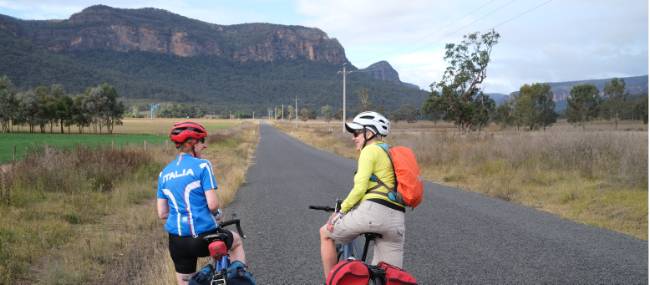
Cyclists on the Glen Davis Road in the Capertee | Ross Baker
Blog home / Effective ways to recover after a long cycle
Effective ways to recover after a long cycle
Most people spend a lot of time training in the lead up to their cycling holiday to ensure they are able to complete and enjoy their ride. With the extra exercise added to your routine, you're bound to feel some level of ache, pain or strain from your training session – or after completing a day pedalling.
Try these helpful recovery tips to help ease any muscle or joint soreness post-exercise and keep your legs strong. These simple tips are effective whether you're riding a bike or walking trails.
Cooling down
Going from an intense or high activity level back down to zero should not be an abrupt change for your body, the last thing you should do when you finish exercising is to stop completely.
If you hop off your bike, give your legs the time to adjust to the change in the environment by pacing around on foot for a while. One of the worst things you could do is to sit down straight away, so be sure to stroll around a bit before sitting down for your flat white!

When you are 5-10 minutes from ending your workout or activity, reduce your pace to a lower intensity to transition your body from activity to a resting state.
When beginning any exercise, you would warm up to activate your muscles, so similarly, allowing your body a cooling down period is also important to reduce the risk of cramping, as well as removing lactic acid from your muscles. This is especially important in cooler temperatures when muscle stiffness is much more pronounced.
Don't forget to stretch
After exercising, do gentle stretches for five minutes to allow your muscles to relax into a resting state; stretching restores your muscles to their normal length, aiding in their recovery.
Focus on the muscles used during the day while you’ve been cycling, such as calves, hamstrings, hip flexors and quadriceps.
Avoid bouncing in and out of the stretch. Instead, you want to move into the stretch until you feel a mild to moderate tension, and hold the stretch for up to 30 seconds.
Fuel yourself
Long walks and extensive pedalling deplete your energy stores, so it’s important to refuel to replace this energy, repair tissues and supercharge your recovery process.
Take advantage of the 30-45 minute post-exercise window where your body maximises the absorption of protein, water and carbohydrates, and aim to have a nutritious snack while after your training session or in between your long cycle. Include some high-quality protein and complex carbohydrates such as granola, energy bars or nuts. Your body will thank you for it later.
Rehydrate and replace fluids
Hydrate, hydrate, hydrate! You lose a lot of fluid during a cycling trip, so you should be replacing fluid throughout the day.
Drinking 1 ½ cups to 2 ½ cups of water per hour for at least 2 hours after exercise is an easy way to boost your recovery as the water supports every metabolic function and nutrient transfer in your body.

Just remember to reduce your water intake as you get closer to bedtime to limit the number of times you have to get up in the middle of the night.
Rest
If you're training to the lead up to your cycling adventure, give your body the chance to rest in between the days you are active. This will give the muscles you've been working on time to recover and avoid the risk of injury and strain from prolonged or intense exercises.
This may not necessarily mean doing no activity at all, but can see you switching to less intense activity or exercises which focus on other areas of your body. For instance, if you did cardio one day, the following day you may want to do weight training instead. If you were cycling all day and want to ease the pressure on your joints, you could opt for a short walk the next day.
Mental and physical rest is equally important when letting your body recover, so getting in enough sleep will allow you to come back refreshed and feeling even stronger the next day.

Preparation
While out on the bike paths, warming up and stretching your muscles before you start can do wonders as it prepares your body for the day ahead. But being prepared for your cycling holiday doesn’t just mean training and ensuring you are fit, you also need to consider a few other things including:
• Ensure your panniers (i.e. saddlebags for your bike) are not overfilled. Our cycle tours include daily luggage transfers so it's important to only take what you need for the day's cycling.
• Wear the right shoes for you. Joggers or training shoes are perfectly fine for our cycling trips - just be sure you have broken them in and don't embark on your bike trip with them fresh out of the box, this is the best way to get blisters!
Taking these few simple steps can help you to enjoy your cycling adventure and limit the aches and pains.
Do you have any extra recovery tips to add? Share your advice in the comment section below!